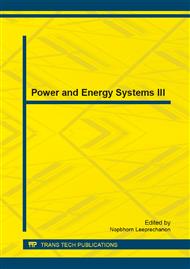p.3
p.7
p.13
p.19
p.24
p.31
p.37
p.43
Evaluation the Role of Multi-Stage Compression and Waste Heat Recovery on Compressed Air Energy Storage System Performance
Abstract:
Compressed air energy storage (CAES) has the potential to improve the quality of renewable electricity from wind and solar. The non-continuous electricity from wind and solar can be stored in terms of compressed air energy, which can be released at peak time of state grid. In this paper, the influences of multi-stage compression and waste heat recovery on characteristic of CAES system were investigated. Results indicated that the adoption of multi-stage compression technology obviously reduced its heat rate, and the adoption of heat recovery improved its energy conversion efficiency. Among the three compression cases in this paper, the compression power consumed per kilogram air for the single-stage compression process was 890.83Kj/Kg, while which of the three-stage compression process with inter-cooler reduced to 524.82Kj/Kg. Meanwhile, the CAES system with three-stage compression and heat recovery had a low heat rate of 3974Kj/Kw.h and a high energy conversion efficiency of 59.92%.
Info:
Periodical:
Pages:
19-23
Citation:
Online since:
January 2014
Authors:
Price:
Сopyright:
© 2014 Trans Tech Publications Ltd. All Rights Reserved
Share:
Citation:


